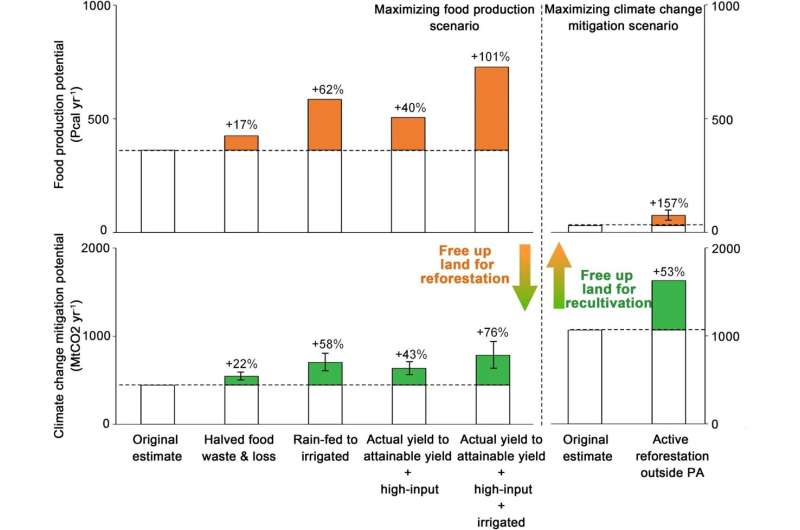This article has been reviewed according to Science X's editorial process and policies. Editors have highlighted the following attributes while ensuring the content's credibility:
fact-checked
peer-reviewed publication
trusted source
proofread
Give abandoned croplands a second chance to boost climate mitigation and food security, urges new study

The reuse of abandoned croplands should be considered by governments as a way to tackle climate change and reduce the environmental impacts of agricultural expansion. This was a key takeaway from a new study led by the National University of Singapore's Centre for Nature-based Climate Solutions under the Faculty of Science, which was published recently in Nature Communications.
As global populations rise and the need to feed the world grows, agricultural lands are expanding, sometimes at the expense of natural habitats such as tropical forests. At the same time, croplands are also being abandoned due to factors such as land degradation, institutional and socioeconomic changes, disasters, armed conflict, and urbanization.
Such abandoned croplands can be found in Europe, Russia, Central and East Asia and the Americas, and covered 101 million hectares globally between 1992 and 2020. This is almost equivalent to the size of Egypt, which has a total land area of about 100 million hectares. The abandonment rate over this period was about 3.6 million hectares a year, which means cropland about 50 times the size of Singapore was being abandoned every year.
But the new study found that better management of these abandoned croplands could emerge as powerful nature-based solutions specifically through cultivation or reforestation. For example, if they are cultivated for food production, there could be less pressure to clear forests to open new croplands; thus contributing to the protection of existing forests. Alternatively, if abandoned croplands are reforested, the young forests could help pull planet-warming carbon dioxide from the atmosphere and contribute to climate change mitigation.
Through analyzing geospatial data, the researchers found that of the 101 million hectares of globally abandoned cropland, 61 million hectares were suitable for cultivation. This would grow enough food to feed between 292 to 476 million people per year, although it would also result in emissions due to the need to clear the vegetation that had grown on the abandoned lands.
Additionally, the researchers also established that 83 million hectares of globally abandoned cropland were suitable for reforestation. If this amount of land was completely planted up, the new forests could help to take in up to 1,066 million tons of carbon dioxide per year—almost equivalent to the annual emissions of Japan.
Some areas of abandoned cropland overlapped between the two categories—researchers found that about half of the 101 million hectares of abandoned cropland was suitable for both cultivation and reforestation. Policymakers would have to weigh the opportunities and trade-offs of either choice, depending on their national circumstances and priorities, and in consideration of other factors.
For example, local policies could affect the attractiveness of whether the land should be used for agriculture or reforestation. Market access and international trade openness could also affect these decisions. Still, the study highlights that a previously neglected land use type—abandoned croplands—could contribute to climate mitigation and food production, and should be factored in national land use decision making.
Dr. Qiming Zheng, who led the study when he was a research fellow at CNCS, said, "In the face of global challenges such as climate change and food scarcity, countries are often faced with the shortage of available land and the tough choice of whether land should be allocated for carbon sequestration or food production."
"But our study has found that abandoned cropland is a largely untapped resource that could help to achieve either or both aims. Nevertheless, it requires an integrative use of scientific analysis of the land suitability and achievable potentials, as well as context-specific local knowledge, to best unlock the potential of abandoned cropland."
More information: Qiming Zheng et al, The neglected role of abandoned cropland in supporting both food security and climate change mitigation, Nature Communications (2023). DOI: 10.1038/s41467-023-41837-y
Journal information: Nature Communications
Provided by National University of Singapore


















